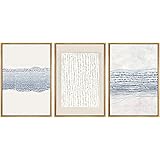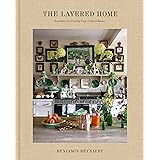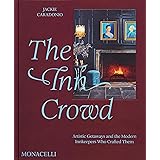Unveiling the 2025 Interior Design Trends: Crafting Timeless and Personal Spaces
As 2025 approaches, the world of interior design is witnessing a profound shift towards spaces that embody authenticity, history, and deeply personal narratives. After viewing the insightful predictions presented in the accompanying video, it becomes clear that fleeting fads are being replaced by design concepts that promise enduring beauty and functionality. These aren’t merely temporary stylistic shifts; instead, they represent a considered evolution in how we conceive and inhabit our most intimate environments.
This year, twelve pivotal interior design trends are set to redefine our homes, moving us towards bold choices, intricate textural layers, and a renewed emphasis on personality-driven aesthetics. Spearheaded by experts like interior and product designer Ashley, this movement inspires homeowners and design enthusiasts to cultivate environments that truly resonate with their unique journey. The focus remains steadfastly on creating spaces that are not only visually appealing but also intrinsically connected to our individual stories and aspirations.
Deeply Personal Home Design: A Return to Authenticity
One of the most compelling 2025 design trends is the profound embrace of deeply personal homes, marking a definitive departure from standardized decor paradigms. Individuals are increasingly seeking spaces that meticulously mirror their unique lives, encompassing their passions, travels, and cherished heritage. This trend transcends mere aesthetics, advocating for a curated layering of meaning through personal collections, bespoke artwork, and distinctive furniture selections.
For example, a hand-carved wooden sculpture acquired during a family sabbatical in Bali transcends its decorative function; it serves as a tangible memoir of that cherished experience. Similarly, showcasing a cherished vinyl collection, a carefully preserved stamp album, or an array of hand-bound books transforms a generic space into a vibrant reflection of one’s intellect and avocations. Conversely, celebrating cultural heritage can manifest through vibrant traditional textiles, a thoughtfully arranged gallery wall featuring generational portraits, or artisanal pieces honoring ancestral craftsmanship. Designing a dedicated artist’s studio, a secluded meditation corner, or a vibrant culinary garden explicitly tailored to one’s daily rituals elevates this personalization, making a home an authentic extension of its inhabitants’ deepest desires. This philosophy aligns perfectly with the contemporary movement of “romanticizing your life,” ensuring that our living environments are authentic expressions of our identity and aspirations.
Formal Entertaining Spaces: Reviving the Art of Conversation
In stark contrast to the casual, open-plan living dominant in recent years, 2025 heralds a magnificent resurgence of formal entertaining spaces. These meticulously crafted areas are specifically designed to foster relaxation and genuine connection among friends and family, deliberately free from digital distractions. We are observing a significant return to dedicated zones for social gatherings, characterized by multiple seating vignettes that facilitate intimate, uninterrupted conversations.
Imagine sumptuous velvet armchairs encircling a statement coffee table, alongside an impeccably styled bar cart ready to serve artisanal cocktails, and a compact sideboard elegantly displaying heirloom servingware. Art, furthermore, assumes a pivotal role within these refined settings, ranging from commanding statement pieces to thoughtfully arranged gallery walls. Each piece contributes an additional stratum of sophistication and frequently sparks engaging dialogue among guests. A practical design strategy involves strategically reconfiguring furniture; pulling sofas and chairs closer together intrinsically cultivates a more intimate configuration. For more compact living areas, integrating an oversized ottoman can offer both a functional coffee table and supplementary seating for company, maximizing spatial efficiency. Conversely, the deliberate application of mood lighting, through sophisticated table lamps, elegant wall sconces, and dimmable overhead fixtures, significantly enhances the inviting ambiance of these revitalized conversation areas.
Heritage Details: Timelessness Through Craftsmanship
Heritage details are experiencing a powerful renaissance this year, fundamentally for their inherent ability to imbue homes with a profound sense of history, enduring timelessness, and exquisite craftsmanship. Deep, resonant woods such as rich walnut and luxurious mahogany are increasingly supplanting the lighter, bleached oaks that characterized previous trends, lending an unparalleled depth and comforting warmth to contemporary interiors. Moreover, a distinct resurgence of classic patterns like traditional stripes and intricate herringbones is evident, particularly across high-quality textiles, plush rugs, and bespoke upholstery.
Intricately carved details, elegant decorative moldings, and vintage-inspired hardware are collectively contributing an air of refined elegance and a perception of permanence to our living spaces. This trend is an ideal choice for connoisseurs who appreciate seamlessly integrating antique charm with modern sensibilities. Heritage details effortlessly complement both contemporary and traditional homes, striking a harmonious balance between established character and current stylistic preferences. An accessible method for incorporating this trend involves selecting one or two premium, heritage-inspired pieces to serve as anchors within a room. A distinguished vintage credenza, a beautifully hand-knotted Persian rug, or the enduring elegance of floor-to-ceiling drapery can introduce this timeless aesthetic into your home, acting as foundational elements upon which you can progressively build a cohesive design narrative.
Architectural Layers: Building Depth and Permanence
Have you ever pondered why certain rooms exude a sense of grounded completeness, even when minimally furnished? The explanation frequently lies in the astute application of architectural layers. Elements such as elegant wainscoting, intricate crown molding, and sophisticated coffered ceilings introduce profound depth, rich texture, and a tangible feeling of permanence into any given space. Consequently, these structural features are projected to achieve unprecedented popularity throughout 2025.
Architectural layers are certainly not exclusive to traditionally styled residences. Even the most minimalist interiors can derive immense benefit from the integration of subtle, yet highly sophisticated architectural enhancements. Furthermore, we are observing a notable rise in bold ceiling treatments, including graceful barrel vaults and dramatically intricate exposed beams, which effectively transform ceilings into breathtaking focal points. Paneled walls, especially those rendered in deep, luxurious wood tones or evocative, moody colors, provide an ideal conduit for introducing both drama and refined elegance. If extensive building or renovation projects are not feasible, you can still infuse architectural interest into your home through decorative furnishings that project a sense of enduring quality. Consider a grand wall mirror featuring a distinguished pediment detail or freestanding bookshelves meticulously crafted with intricate molding profiles. Embracing this trend will undoubtedly confer enduring longevity upon your spaces, cultivating that sought-after layered aesthetic universally admired in contemporary design.
Nostalgic Styles Reimagined: Bridging Past and Present
The design sphere is taking a deeply sentimental trajectory, celebrating a compelling revival of nostalgic styles, albeit with a refreshing and distinctly modern interpretation. We are witnessing affectionate nods to influential movements such as the Arts and Crafts, Art Nouveau, and Art Deco, each re-emerging with contemporary relevance. Envision the fluid, organic lines characteristic of Art Nouveau furniture making a significant comeback, infusing interiors with a soft, inherently romantic sensibility. In contrast, the audacious geometry and shimmering metallic accents synonymous with Art Deco are bestowing an undeniable glamour and sophisticated gravitas upon diverse spaces.
Even whimsical floral wallpapers and meticulously detailed vintage-style tiles are re-emerging, imparting an old-world charm that feels both authentic and current. This trend deliberately avoids a literal recreation of historical periods; instead, it skillfully reinterprets these enduring classic styles to harmoniously align with contemporary living paradigms. To thoughtfully introduce a touch of nostalgia into your rooms, consider incorporating a few carefully selected antique accessories, investing in stylized textiles and wall coverings, or choosing furniture pieces adorned with elegant carved details. This approach fundamentally celebrates handcrafted elements that evoke a powerful sense of historical reverence, honoring the profound beauty and artistry intrinsic to pivotal design eras throughout history.
Warm Earthy Tones: Grounding and Sophisticated Hues
Warm earthy tones are orchestrating a magnificent comeback within the design landscape, eliciting widespread excitement among discerning decorators and homeowners alike. Imagine the rich, grounding hues of terracotta, the serene depth of olive greens, the vibrant warmth of ochre, and the enveloping comfort of deep, luxurious browns that instantaneously cultivate a sense of rootedness. These colors transcend mere comfort; they introduce an unparalleled level of sophistication that feels intrinsically timeless and perpetually inviting.
Moreover, these versatile hues are incredibly adaptable across a myriad of design applications. You can make an impactful statement by color-drenching an entire room, creating an immersive and cohesive environment, or alternatively, maintain a subtle presence through strategically placed textiles such as plush throw pillows and artisanal rugs. Harmoniously pair these colors with organic materials like natural wood and unpolished stone to achieve a look that feels inherently cohesive and thoughtfully intentional. Regardless of whether your aesthetic leans towards a sleek modern vibe or embraces a more classic, traditional style, earthy tones possess the unique ability to imbue your space with a welcoming warmth and an understated elegance. If you are not yet prepared to commit to painting an entire room in a rich mocha, begin modestly by integrating earthy accents: a beautifully textured clay vase, a rust-colored linen throw pillow, or a luxurious aubergine wool rug. Layer these elements thoughtfully over a neutral base to allow the colors to truly pop without overwhelming the spatial composition.
Textural Layers: The Secret to Design Depth
Creating intricate textural layers is a paramount concern this year; indeed, texture consistently serves as the clandestine weapon wielded by master designers. This principle centers on the meticulous layering of diverse materials to conjure profound depth, inviting warmth, and captivating visual interest within a space. From the tactile quality of plastered walls and the inviting nub of woven upholstery to the exquisitely grained surfaces of finely crafted wood furniture and the rugged elegance of natural stone accents, layering textures intrinsically imbues a room with a distinct character and an enveloping warmth.
Therefore, meticulously consider combining materials in a manner that consciously introduces contrast into your interiors. Harmoniously juxtapose smooth, sleek surfaces with materials possessing nubby, organic, or richly textured qualities to establish a balanced and engaging composition. Furthermore, always remember to incorporate natural elements to firmly ground the entire space; frequently, the most compelling textures are discovered within the inherent beauty of nature. Embrace the unique versatility and organic charm of materials like jute, rattan, linen, and raw timber. Texture stands as the quintessential secret ingredient that transforms an adequately designed room into an extraordinarily exceptional one. Consequently, wholeheartedly embrace this profound concept and witness firsthand how the art of textural layering can dramatically amplify depth, visual intrigue, and profound comfort within your cherished home.
Moody Material Drenching: Immersive Sophistication
Moody color palettes, renowned for their dramatic flair, are firmly established, but this year we elevate the concept significantly with material drenching. This innovative approach involves a bold and expansive application of a singular material, such as luxurious marble, intricate tile, or a captivating pattern, throughout a space. The result is a richly enveloping aesthetic that feels simultaneously dramatic and unequivocally sophisticated. Designing a room in this manner magnificently showcases the inherent beauty of the chosen material, yielding a cocoon-like atmosphere that is perfectly suited for spaces demanding a sense of intimacy and luxury, including formal dining rooms, lavish bathrooms, chic home bars, or even serene bedrooms.
To successfully execute this trend, it is crucial to thoughtfully integrate elements of lightness into the space. This can be achieved through strategically placed mirrors that amplify light, or by incorporating metallic accents that add a subtle gleam. Opting for a more pared-back accessory composition further ensures that the primary focus remains squarely on the hero material you are highlighting. This intentional restraint allows the chosen texture or pattern to speak volumes, creating an environment that feels both opulent and meticulously curated.
The Allure of Handcrafted Pieces: Soul and Connection
The contemporary design ethos is consciously moving away from ubiquitous mass-produced decor, instead embracing the intrinsic beauty and authenticity of handcrafted objects. Whether it is a meticulously hand-thrown ceramic vase, an intricately woven textile, or a bespoke piece of custom-made furniture, these artisan creations infuse your living space with an unparalleled sense of authenticity and artistic integrity. The inherent beauty of handcrafted decor lies precisely in its imperfections—those subtle variations and unique characteristics that unequivocally convey that an item was created with meticulous care by human hands, not by a soulless machine. This movement is fundamentally about imbuing your home with soul and fostering a deeper connection to the objects within it, simultaneously championing local artisans and dedicated makers.
What makes this particular trend exceptionally compelling is its remarkable versatility. Handcrafted items integrate seamlessly into virtually any design aesthetic, from the clean lines of modern minimalism to the rustic charm of farmhouse styles, the eclectic vibrancy of bohemian interiors, and the enduring grace of classic traditional decor. To thoughtfully incorporate this trend, begin modestly by introducing handcrafted accent pieces, such as unique pottery, beautifully woven baskets, or elegantly hand-carved wooden trays. If you are prepared to make a more substantial statement, consider investing in a larger, signature piece, perhaps a bespoke dining table or an artisanal, handmade light fixture. Exploring local artisan markets or reputable online platforms like Etsy can reveal a wealth of one-of-a-kind treasures, each promising to enrich your home with its unique narrative.
Avant-Garde Design Moments: Pushing Boundaries
For those poised to make a bold statement this year, avant-garde design moments offer an exhilarating pathway to expressive interiors. This trend wholeheartedly embraces the incorporation of audacious, entirely unexpected items that deliberately challenge and push the conventional boundaries of design. These are precisely the pieces that command attention, provoke thought, and inevitably spark fascinating conversations among observers. An avant-garde moment might manifest as a strikingly sculptural piece of furniture, perhaps an asymmetrical armchair that defies conventional form, or an oversized abstract painting that assertively dominates an entire wall, transforming it into a dynamic focal point. It could also be a uniquely conceived lighting fixture that functions equally as a work of art, or an unconventional decorative object that serves as an immediate catalyst for dialogue.
The truly exciting aspect of this trend lies in its inherent versatility. You are certainly not obligated to undertake a complete redesign of an entire room to embrace the avant-garde aesthetic. A single, strategically chosen standout piece possesses the transformative power to completely revitalize a room’s character. A highly effective design approach involves selecting one avant-garde piece to serve as the undisputed focal point of your room. Consequently, maintain the surrounding decor in a simplified, understated manner to allow that singular piece to truly shine. For instance, pair a dramatically unexpected light fixture with timeless, understated furniture, or display an unconventional piece of art within an otherwise more subdued and classic space. This careful curation ensures maximum impact while maintaining overall design harmony.
Embracing Patina and Aged Materials: Stories Etched in Time
We are consciously bidding farewell to the era of hyper-polished perfection, extending a warm welcome to materials that authentically celebrate the inherent beauty of patina. This compelling trend venerates surfaces that gracefully age over time, developing a unique character and narrative. Envision the sophisticated allure of unlacquered brass, the rich history embedded in weathered wood, the raw elegance of natural stone, and the evolving beauty of aged zinc and copper. These materials, over time, acquire a distinctive character, meticulously telling a story and infusing profound depth into your home’s aesthetic.
Unlacquered metals, for instance, are designed to naturally oxidize, progressively developing a rich patina that adds an irresistible charm and visual complexity. Reclaimed wood, conversely, carries its own inherent history, evidenced by unique knots, distinctive grain patterns, and beautiful imperfections that render each piece singularly one of a kind. Even natural stones such as marble, travertine, and alabaster, with their intricate veining and subtle inherent flaws, are gaining significant traction in their raw, unpolished forms, celebrating their authentic, untouched beauty. To gracefully incorporate this trend, actively seek out furniture, hardware, and decorative elements that proudly showcase natural, evolving finishes. Consider swapping out highly polished hardware for unlacquered alternatives, or select a reclaimed wood dining table that openly displays its rich, storied past. These materials integrate beautifully into both modern minimalist and traditional maximalist spaces, adding a soulful, deeply storied layer to your home’s enduring character.
The Art of Mood Lighting: Crafting Ambiance and Comfort
Lighting stands as undeniably one of the most profoundly transformative elements within interior design, and for 2025, the paramount focus is unequivocally on mood lighting. The days of harsh, singular overhead illumination are steadily receding; instead, our collective attention is directed towards meticulously crafting layers of light that seamlessly introduce warmth, dimension, and an enveloping ambiance into our cherished spaces. Many individuals now spend extended hours working outside their homes, rendering the creation of a warm, profoundly welcoming environment—a sanctuary to return to after a demanding day—an absolute top priority.
This paradigm shift necessitates the establishment of a cozy mood through the strategic layering of diverse lighting sources. This involves a thoughtful combination of hanging fixtures, elegant wall sconces, intimate table lamps, functional floor lamps, artistic picture lights, and even the gentle flicker of candles. Each distinct light source serves a specific, vital purpose: task lighting provides essential functionality for activities, ambient lighting bathes the space in an overarching coziness, and accent lighting precisely highlights decor or emphasizes architectural features. To infuse your space with these rich layers of moody illumination, begin by critically re-evaluating your current lighting scheme. Introduce a table lamp or two into your living room, install dimmer switches on your primary overhead lights, or experiment with adding an art light to illuminate a treasured piece or a small lamp on a bookshelf. This deliberate layering of light throughout your space consistently creates an environment that is both inherently warm and profoundly welcoming, embodying the best of 2025 interior design trends.











